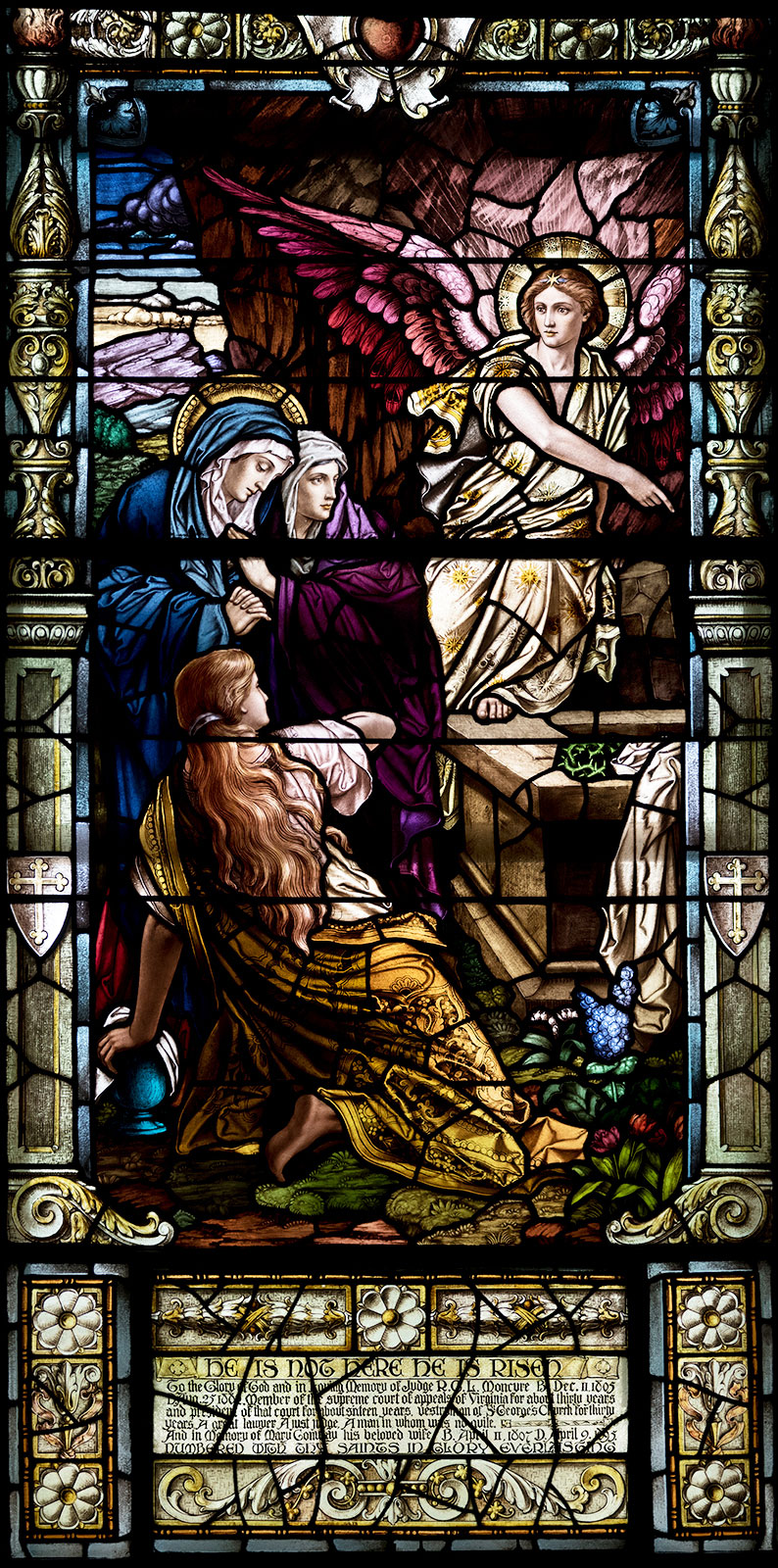
Subject: Three Women at the Tomb
Inscription: “He Is Not Here, He Is Risen”
Dedication: In memory of Judge R. C. L. Moncure, December 11, 1805—August 25, 1882, and Mary Conway Moncure, April 11, 1807—April 9, 1895. A man in whom was no guile
Maker/Date: The maker has not been positively identified though we suspect George Hardy Payne who also did a similar window at the United Methodist Church in Front Royal, Va.
The Payne Studio went through 4 generations before they closed in the 1980s.
George Payne I started as a glass painter for Clayton & Bell in London. He immigrated to Montreal and then to Orange, N.J. His son George II took over the business, followed by George Hardy Payne and then by George Leslie Payne. Rohlf Stained Glass bought out the company after George L. died.
The date in library publications is 1908. No documentation was found to support that date.
The image was first painted commercially by Bernhard Plockhurst (1825-1907) a German painter.
Description – The window depicts the shock of the tomb being open and Jesus not being there. Artistically, the drama of the event is conveyed by the angel pointing to the empty tomb and Mary Magdalene recoiling from the news. The action shifts from top right to bottom left with the two other figures remaining somewhat calm, but comforting each other, providing a contrast to the other characters. The tension is heightened by the closeness of the figures to the observer. The size of the characters reminds us of the importance of the event at hand and reinforces the drama.
All of the Gospels speak of the resurrection event but the details differ. Both of the Easter morning windows are predominantly taken from Mark’s Gospel. Mark’s account is the shortest and does not provide additional stories of Jesus’ appearances afterward but promises he will appear again. Mark lists the women in the window – Mary Magdalene, Mary the mother of James and Salome, followers of Jesus and possibly Mary’s sister. All three had followed Christ in Galilee and now to the grave. They found the stone had been rolled away from the entrance. A man or two men dressed in bright white clothes (angels) told them Jesus had risen. In John’s account, Mary Magdalene alone found the tomb empty. She told Peter and John who came running to find the linen wrappings lying alone in the tomb. They returned home while Mary Magdalene remained where she encountered two angels and then the risen Christ. Luke’s account has Joanna – the wife of King Herod’s steward replacing Salome. Mathew’s gospel includes only Mary Magdalene and “the other Mary.”
A messenger is included in all Gospel accounts which has been translated to “angel”. The angel in the window is female which varies from all Gospel accounts but fits the more popular concept of angels. Mark clearly says it is a “young man in a white robe seated on the right side” Luke differs from the other Gospels by including two angels. Angels have many meanings in the Bible – this angel is clearly the messenger type.
It is early in the morning. At the top of the window, the light comes over Golgotha – note the three crosses for the crucifixions earlier in the week. John speaks of “very early, and still dark” (John 20:1) where Mark says it is “very early in the morning… when the sun had risen” (Mark 16:2). The tomb is not a traditional Jewish tomb but a modern box tomb and the cover has been removed. (However, the rock background may be shown behind the angel). There is no stone that has been rolled away and no guard as described by Mathew. The angel is not in the tomb where the body of Christ had been as recorded in all accounts.
So why were the women there observing Jesus’ body? Mark suggests that they wanted to attend to the body in their own special way after the Passover Sabbath.
Mary Magdalene is holding on to a blue vase. Inside the blue vase would have been perfumes and ointments to perform their own rites on Jesus’ body in preparation of burial, traditionally performed by Jewish women. She is dressed in vivid garments with red hair. This refers to her checkered past as one possessed by demons but as one who loved Jesus. Her hair is exposed and relatively loosened which would be a sign that she is not chaste.
Mary the mother has a halo and is praying fitting Luke’s account of a praying woman. Salome is transfixed, staring at the vacant tomb, in shock while at the same time comforting Mary the mother. They function as important witnesses of the event.
On the right side of the window, there are two symbols of Jesus’ resurrection – the white burial garment and the crown of thorns. The latter specifically identifies Jesus. If Jesus had been stolen, his body would have remained wrapped – the garment would not have been left behind. It is clear that Jesus has been transformed. Three of the Gospels, Mathew, Mark, and Luke speak of a larger cloth that would have covered the body. John uses “linen cloths” which some have interpreted as a face cloth but does not include the larger cloth.
The flowers (lilies of the Valley, Hyacinths, tulips) are spring flowers and may symbolize the new life stemming from the resurrection for Christ’s followers. The lilies open toward the heavens as Christ has risen from the tomb. New life is also apparent on the shining suns on the angel’s garments and also is a symbol for Christ.